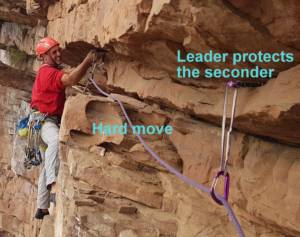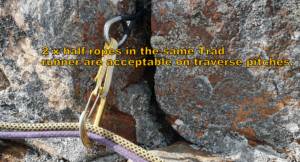We look at how to lead traverse pitches. What’s safe, what’s efficient and what works best when protecting the Seconder/s. These guidelines are particularly important on Trad routes but can also be used on Sport climbs.
The main factor is the number of people seconding each climbing pitch.
Firstly on traverse pitches with 2 Seconders, do not simul- climb them, as there is a very real chance of a rope being cut in the event of a Seconder falling.
The Leader, when coming to a hard move, should place protection. Then after doing the move, the Leader must place more protection, to safe guard the Second doing the hard move. A common error!
So going from the the most simple to the most complicated.
-2 climbers with 1 Single (Full rope) – leader clips the rope through all the running belays.
-2 climbers with Double ropes ( 2 half ropes). The Leader can either clip the ropes
alternatively (this is best) or through the same karabiner at each protection. Remembering that when 2 half ropes are clipped to the same running belay, the Impact Force almost doubles on that point in the event of a leader fall, when falling from above. BUT on a traverse, due to the pendulum effect, the force on a runner is seldom more that approx the 1.5 times the weight of the climber. This explains why sketchy protection actually holds if the Leader or Second takes a fall.
-3 climbers with Double ropes (2 x half ropes). One Seconder on each strand. The
Leader then clips the “first” Seconder to the outside of each runner, making it easy to un-clip. Also making sure no ropes are crossed over as they do so.
For more information on course like the MDT Multi-pitch Supervisor contact gavin@peakhigh.co.za


